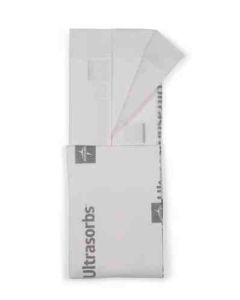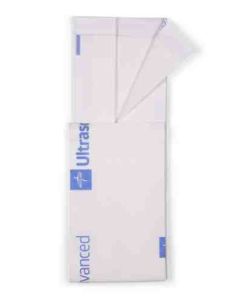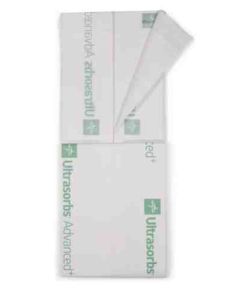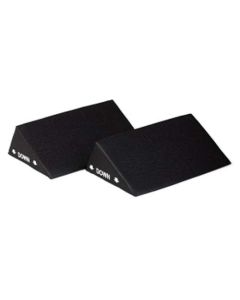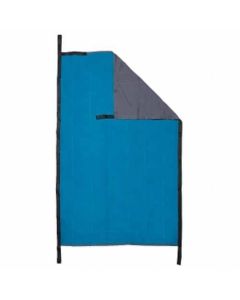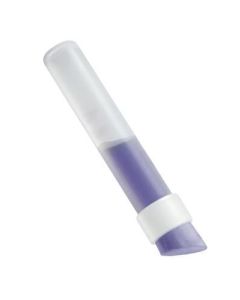Pressure Ulcer Prevention
A pressure ulcer is a breakdown of the skin and damage to underlying tissue caused by pressure of body weight. Pressure ulcers are also called bedsores or pressure sores. Incontinence, moisture, friction and shear can increase the risk of pressure ulcers. Incontinence and moisture contribute to maceration, which may make skin more sensitive to breakdown from pressure. Friction and shear may remove epidermal layers, reducing dermal tissue protection and making skin vulnerable to injury and pressure.¹
In most cases, pressure ulcers occur to patients confined to a bed or a chair.² A pressure ulcer may show up as a subtle color change on the skin. With light skin tone, it may show up as red, purple or brown. With dark skin tones, it is more likely to appear gray, purple or black.³
Pressure ulcers can negatively impact the physical health of patients and the financial health of a facility.
PATIENT/RESIDENT STATS
37.5%
Greater risk of pressure ulcers in individuals with both incontinence and immobility4
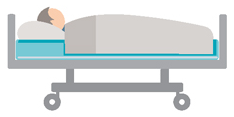

60,000
Approximate number of individuals who will develop a new pressure ulcer annually in the UK5


Incontinence-associated dermatitis (IAD) is prevalent to:
Double incontinence is


42% of hospitalised adults


83% of incontinent ICU patients


41% of residents in long-term care
50-70%
more common than urinary or fecal incontinence alone4


FACILITY STATS
£1,214 TO £14,108
£3 BILLION
Approximate cost of treatment per individual pressure ulcer
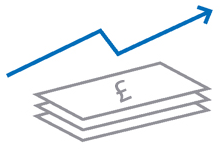

Estimated yearly cost of treating pressure ulcers5


References
¹ Cooper K. Evidence-Based Prevention of Pressure Ulcers in the Intensive Care Unit. Critical Care Nurse. 2013;33(6):57-66. Available at http://ccn.aacnjournals.org Accessed November 9, 2015.
² NICE, Pressure ulcers: prevention and management, April 2016, Available at www.nice.org.uk
³ Medline University, eCourse " Pressure Ulcer Prevention Program: Course for Nursing Assistants” available at www.medlineuniversity.com
4 Langemo D, Hanson D, Hunter S, et al. Advances in Skin & Wound Care. The Journal for Prevention and Healing. 2011;24(3):126-140. Available at www.nursingcenter.com - Accessed November, 2015
5 Wound Care today, 2013, p.7. Pressure ulcer prevention in the current NHS: setting the scene. Rosie Callaghan. Rosie Callaghan is Tissue Viability Nurse Specialist, Worcester CCG Nursing Homes and Worcester Health and Care Trust, Worcester.
6 Ermer-Seltun, J. Practical Prevention and Treatment of Incontinence-Associated Dermatitis – a Risk Factor for Pressure Ulcers. Ostomy Wound Management. February 18, 2011. Available at www.o-wm.com - Accessed November, 2015
7 Journal of Wound Care. 2012 Jun;21(6):261-2, 264, 266. The cost of pressure ulcers in the United Kingdom. Dealey C1, Posnett J, Walker A 1Uni¬versity Hospital Birmingham NHS Foundation Trust, Queen Elizabeth Medical Centre, Birmingham, UK.
Wearing gloves is something that all healthcare professionals have in common. Gloves create an effective barrier for both the clinician and the patient. Despite this protective barrier there is still a need to perform hand hygiene procedures. In 2009 the World Health Organization published “5 moments of hand hygiene”¹ which include, before touching a patient, before you clean or perform sterile procedures, after exposure to bodily fluid, after touching a patient, and after touching any patient’s surroundings.
Constant hand washing and hand sanitizing must be done in order to prevent the spread of infection however it can cause skin irritation. The irritation triggers skin to start a self-repair process. If the hands are continually going though this cycle of breaking down and repairing, normal skin is unable to be formed. The poor condition of the healthcare professional hands can directly and negatively affect their job in several ways.
Germ Transmission
According to the NHS professionals, the most common mode of transmission of disease is by pathogens, and 80% of those pathogens are transmitted by the hands.²
Escherichia Coli (E. Coli) can live on a surface for up to 16 months while Staphylococcus Aureus (MRSA) up to 7 months.³ These germs know no boundaries and can live anywhere including damaged skin.
Cuts, cracks or fissures are ideal places for microorganisms to plant themselves; it also makes it extremely easy to transfer from nurse to patient.
Discomfort Due to Damaged Skin
Hands that are dry, cracked, scaly or rough are especially sensitive to discomfort caused by alcohol based rubs.
However alcohol based rubs are less harmful to the skin than soap and water as they help retain natural lipids and incorporate vital emollients.³
Despite benefits of using the rub many users prefer hand washing in order to avoid the stinging or burning caused by the alcohol based product.
A reaction to an alcohol based hand antiseptic is typically a sign of pre-damaged skin, it is recommended that a caregiver who does experience this resist reverting to soap and water and should use the rubs in conjunction with professional grade hand lotions.
Allergic Reactions
In some extreme cases occupational related contact dermatitis can develop from the frequent and repetitive use of hand hygiene products.
Contact dermatitis as both an irritant and allergy can surface as dry, itchy, irritated areas around the hand or other areas that have been exposed to soaps, solvents, and cleansers.4
Even though this is an acute and very manageable allergy it is crippling to a career of anyone working as a healthcare provider.
References
¹ World Health Organisation, "Five moments for hand hygiene", available at www.who.int
² NHS, Repport on Standard Infection Control Precautions, , available at www.nhsprofessionals.nhs.uk
³ Medline University, eCourse "Hand Hygiene Program: Basic Principles", available at www.medlineuniversity.com
4 National Center for Biotechnology Information, "Occupational irritant and allergic contact dermatitis among healthcare workers", available at www.ncbi.nlm.nih.gov
A caregiver encounters many different skin conditions. Among the most common are those caused by moisture, incontinence, friction and shear. Prolonged exposure to moisture can lead to incontinence-associated dermatitis, intertriginous dermatitis or periwound moisture-associated dermatitis.
Pressure
Pressure ulcers can occur when a large amount of pressure is concentrated on one part of the skin over a short period of time or in the contrary when a moderate amount of pressure is applied over a longer period of time. This can happen through the pressure from a bed or a chair for example.
The extra pressure disrupts the flow of blood through the skin which causes the skin to starve of oxygen and nutrients, and begins to break down, leading to the formation of an ulcer.¹
Friction
Friction is the resistance to motion in a parallel direction relative to the common boundary of two surfaces.³ Friction increases when skin rubs against a bed sheet or other surface.
Wet skin is easily abraded or blistered by friction so minimising or eliminating skin exposure to friction is important in preventing pressure ulcers as well as incontinence-associated dermatitis.4 A friction injury is visible because it occurs on the skin.
Shear Strain
Shear occurs when the bone moves in the opposite direction to the skin surface, for example when a patient or resident slides down in bed.
Shear forces distort deep tissues, especially those near bony prominences.² Incontinence and perspiration can intensify shear forces. A shear injury is less visible because it occurs underneath the skin.
Moisture-Associated Skin Damage
Moisture-associated skin damage encompasses distinct skin conditions caused by excessive and continued exposure to moisture: wound exudate, urinary and/or fecal incontinence, or perspiration.
Identifying the cause of skin damage helps ensure appropriate management and prevention interventions.5
Periwound Moisture- Associated Dermatitis
Drainage is normal during the inflammatory stage of wound healing. But excessive drainage can cause the periwound skin to macerate and even break down.
This is especially a concern with chronic wounds, which contain a higher concentration of proteolytic enzymes than acute wounds.5
References
¹ NHS, Pressure ulcers, Available at www.nhs.uk - Accessed November, 2016
² MASD vs Pressure Ulcer: What Is That Yellow Stuff? Presented at WOCN 46th Annual Conference. June 24, 2014. Available at www.prolibraries.com - Accessed November, 2015
³ Terms and Definitions Related to Support Surfaces. National Pressure Ulcer Advisory Panel Support Surfaces Standards Initiative. National Pressure Ulcer Advisory Panel. Available at www.npuap.org - Accessed November, 2015
4 Langemo D, Hanson D, Hunter S, et al. Advances in Skin & Wound Care. The Journal for Prevention and Healing. 2011;24(3):126-140. Available at www.nursingcenter.com - Accessed November, 2015
5 Dowsett D, Allen L. Moisture-Associated Skin Damage Made Easy. Wounds UK. 2013;9(4): 1-4. Available at www.wounds-uk.com - Acc
While pressure ulcer prevention is the objective, pressure ulcers may still occur. Some people are at greater risk than others for developing a pressure ulcer. It is important to consider how much pressure is being applied and for how long and to identify the patients and areas of the body that are ‘at risk’ for developing pressure ulcers.
Patients at Risk
There are many risk factors that can be associated with the development of pressure ulcers. Individuals that are immobile are patients at higher risk of pressure ulcer as they often stay in the same position for a while and cannot change position by themselves. This includes: paralised patients, fracture, coma, condition or disease that makes it difficult to move the body or parts of the body.
Incontinence is also a very important factor and patients who cannot control their bladder or bowels are at greater risk of acquiring pressure ulcers. Due to incontinence, the skin is exposed to moisture for a prolonged period of time and is more vulnerable. Other risk factors may include poor nutrition; health conditions such as diabetes, dementia, Alzheimer's, Parkinson's, schizophrenia; or age – ageing skin being more vulnerable.¹
Areas at Risk
If the circulation is cut off from too much pressure on a particular area of the body over a period of time, a pressure ulcer will occur. Certain parts of the body are at greater risk for pressure and pressure ulcers.
In general, the areas that are most at risk are those where there is a bony prominence and not much “cushion” for protection such as heels, knees, hips, elbows, occiput (back of the head), ischial tuberosities (sitting bones), shoulders, or sacrum.²
References
¹ NHS, Pressure ulcers, Available at www.nhs.uk - Accessed November, 2016
² Medline University, eCourse " Pressure Ulcer Prevention Program: Course for Nursing Assistants” available at www.medlineuniversity.com
Skin breakdown is a common, costly and painful problem and the need for protection is real. Pressure ulcers are one of the most preventable healthcare issues. An effective pressure ulcer prevention program can lower mortality rates during care and reduce the costs of care by a considerable amount. It is important that every effort is made to prevent pressure ulcers.
Redistributing Pressure
- Heels: If the patient is completely immobile, you can use a heel protection device to off load the heel and so that the heel no longer touches the bed. Heel protectors are a great solution to redistribute the pressure through the calf. An alternative option is to use a pillow under the calf. Be careful how the pillow is placed so it does not cause injury to the Achilles tendon or hyperextend the knee.
- Trochanter: When positioning a patient in the bed, avoid positions that place weight directly on the hip.
- Sacrum/Coccyx: The sacrum is one of the most common areas where pressure ulcers develop. Proper positioning can help relieve pressure on the sacrum and coccyx.
Repositioning
One of the most important ways to help prevent pressure ulcers is to redistribute pressure with frequent repositioning.
- Bedbound: Bedbound individuals may need to be turned every one to four hours, depending on their condition.
- Chairbound: Chairbound individuals should be repositioned at least every hour. For individuals who are capable, encourage them to reposition themselves every 15 minutes.
Turning Schedule
A turning schedule tells caregivers when and into what position the individual should be placed. It can be a simple chart that for patients who spend most of their time in bed but who can sit in a chair for short periods of time.
Repositioning a patient sometimes requires a helper or assistive device. It is important to protect both you and your patient from injury.
Caring for Individuals with Incontinence
You should:
- Always monitor and record the patient’s pattern to help develop a care plan.
- Provide toileting opportunities by prompting the patient to go to the bathroom on a regular schedule. Could be as frequent as every hour with the goal to keep the patient dry.
- Provide gentle skin care with a no-rinse, ph-balanced cleanser daily and immediately after every episode of incontinence.
- Thourouhly inspect the skin folds for residual stool or urine.
Protect the skin after each incontinence episode with a high-quality moisture barrier.
Use of Continence Management Products
There are a variety of absorbent disposable products available for continence management. Continence management products are designed for protection against moisture, managing odor, and prompting autonomy and dignity.
It is best to select continence management products that wick moisture away from the skin, providing a healthier skin environment that allows air flow while acting as a barrier to moisture.
Absorbent disposable continence management products may be appropriate to provide protection against moisture based on each individual’s need. The most appropriate product is based on the user’s mobility, mental capacity physical ability, severity of incontinence and preference.
References
¹ Cooper K. Evidence-Based Prevention of Pressure Ulcers in the Intensive Care Unit. Critical Care Nurse. 2013;33(6):57-66. Available at http://ccn.aacnjournals.org Accessed November 9, 2015.
² NICE, Pressure ulcers: prevention and management, April 2016, Available at www.nice.org.uk
³ Medline University, eCourse " Pressure Ulcer Prevention Program: Course for Nursing Assistants” available at www.medlineuniversity.com
Related Products

